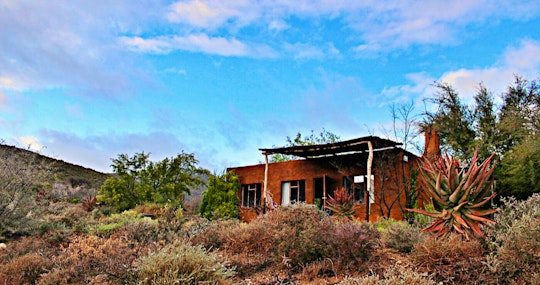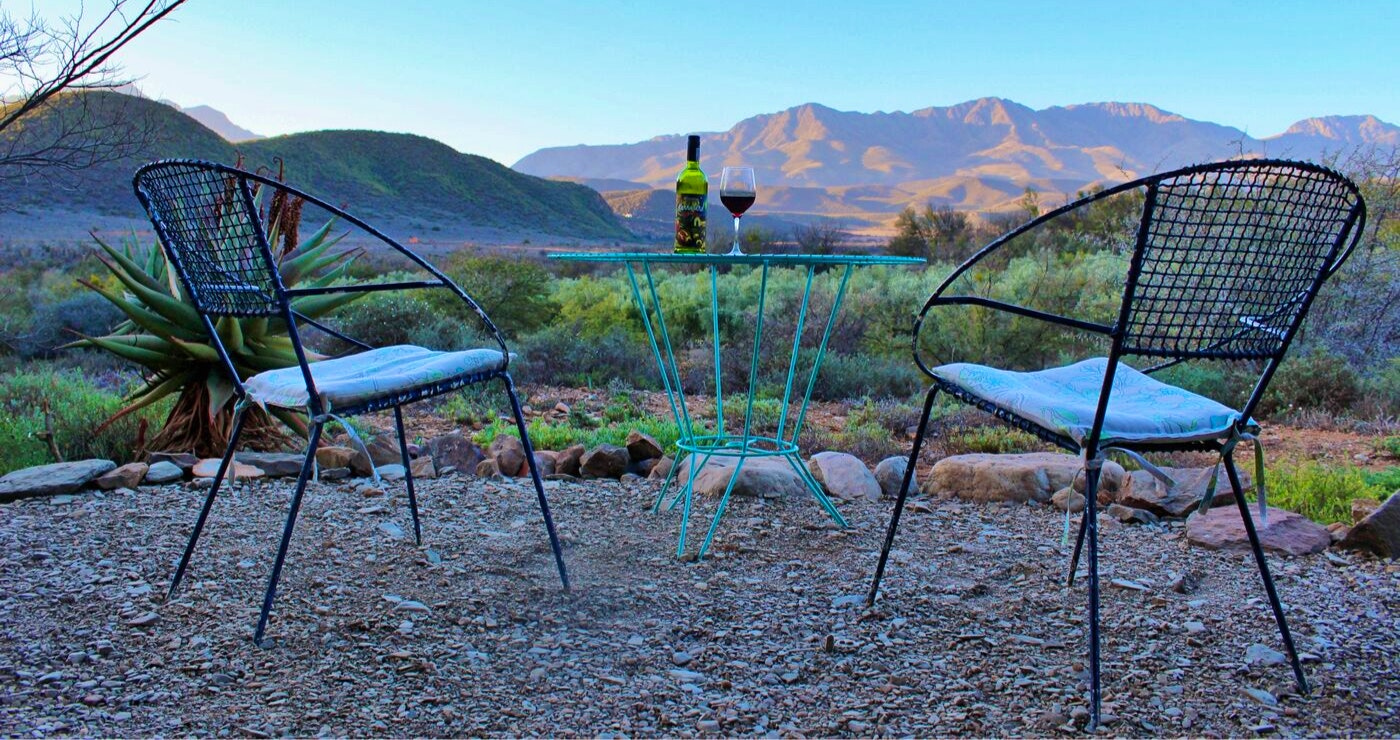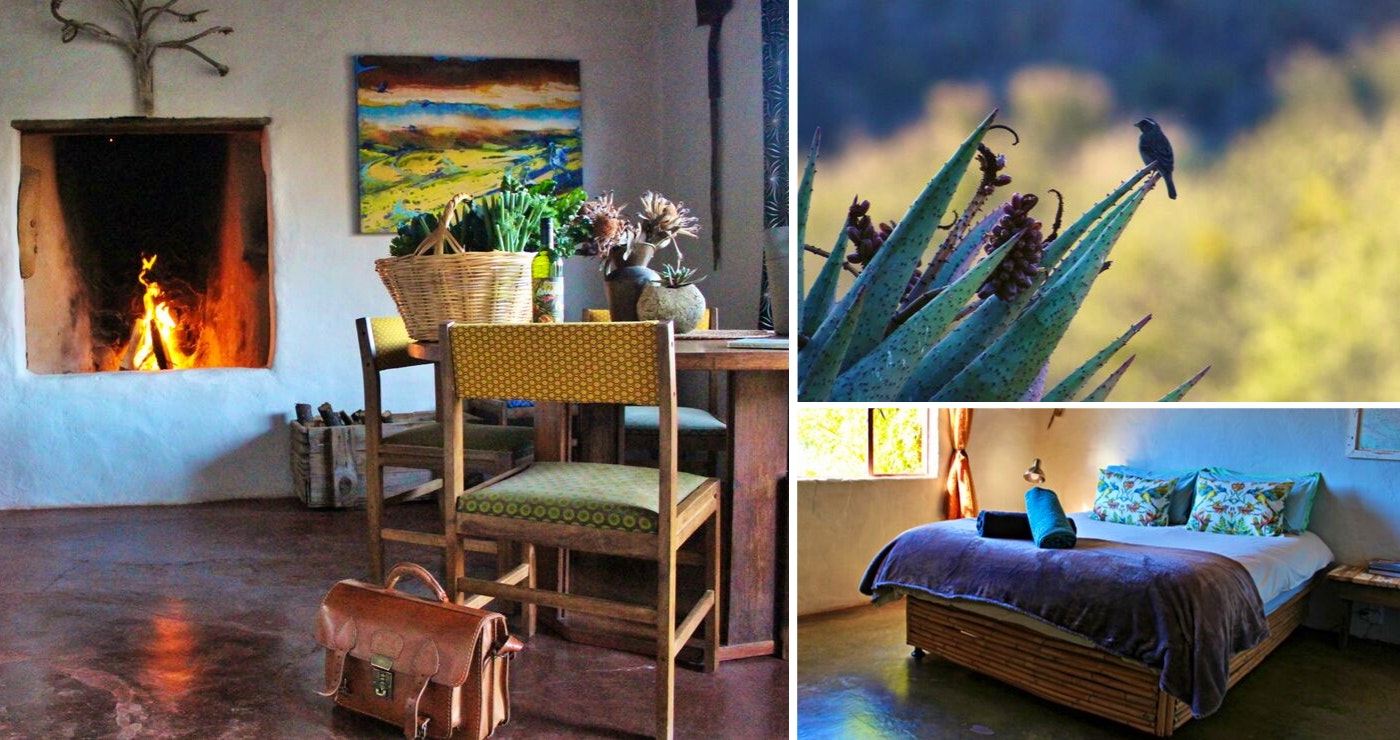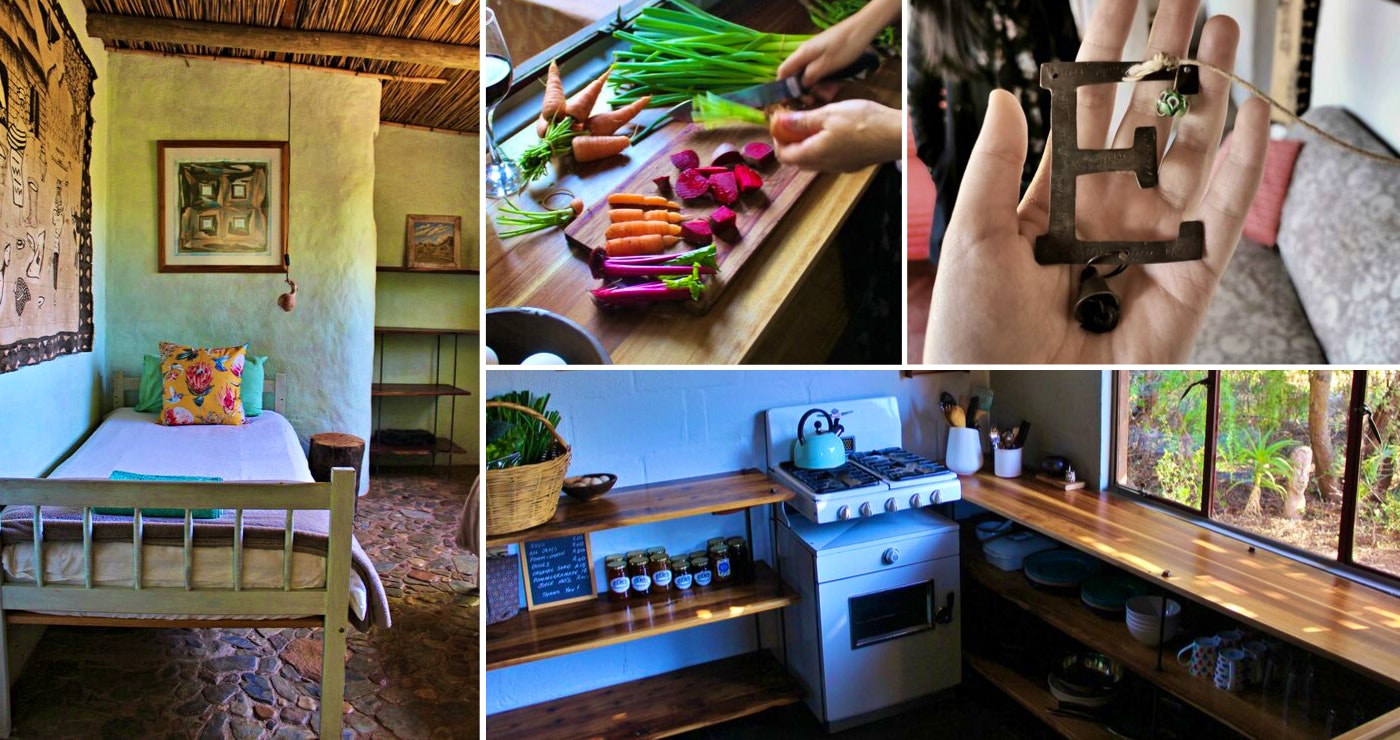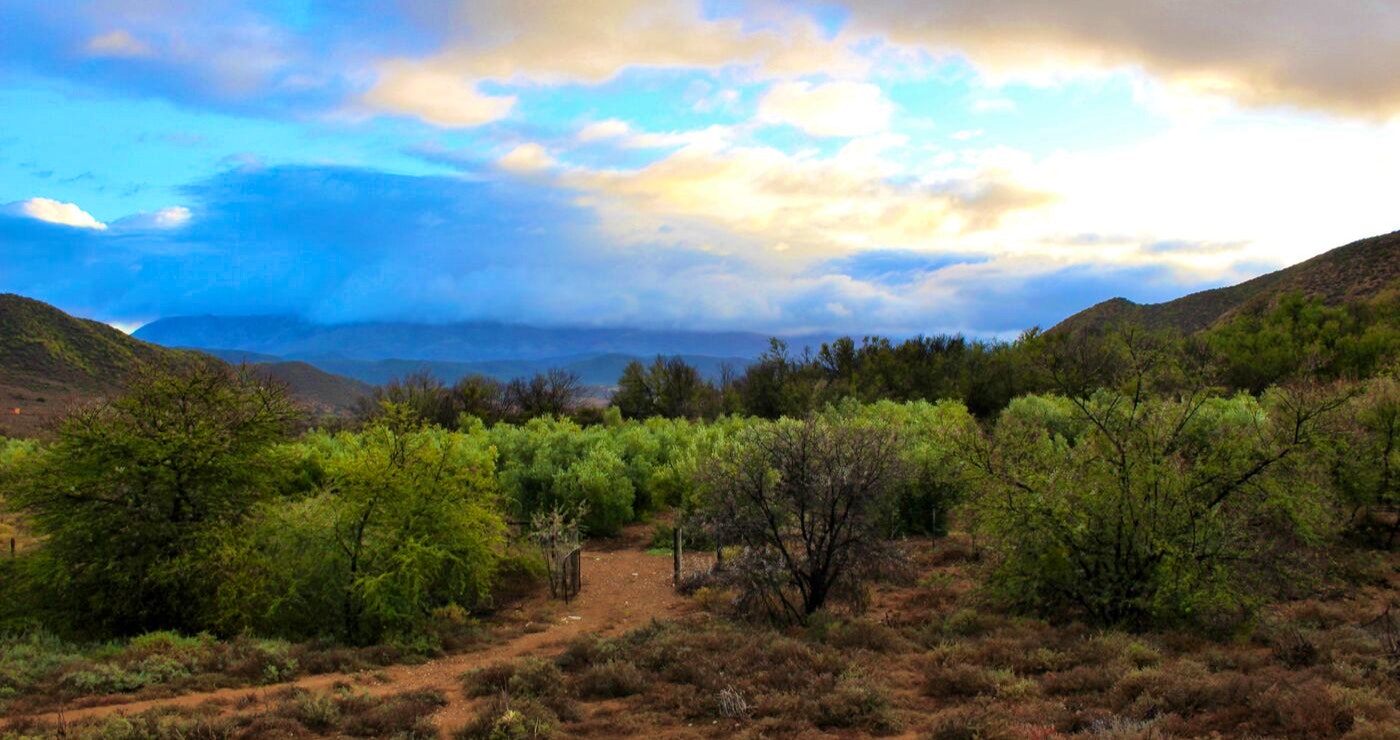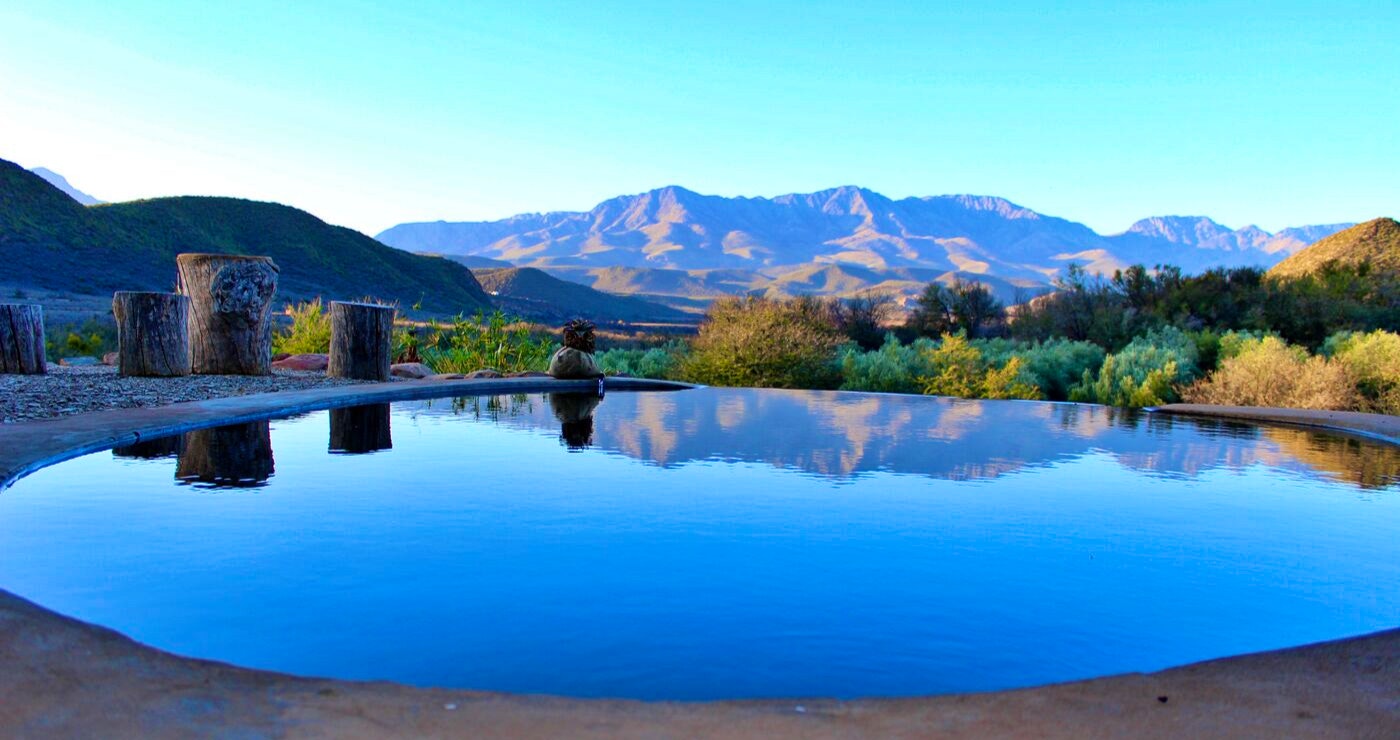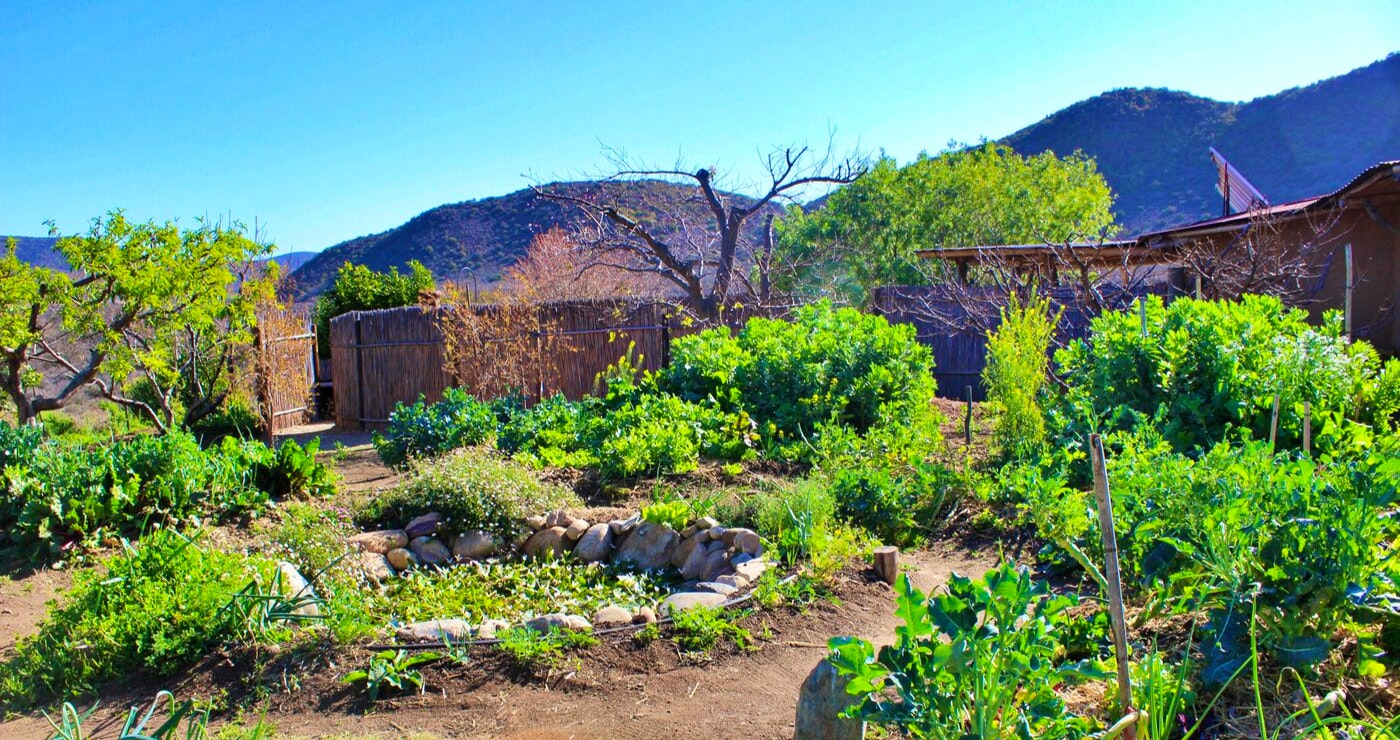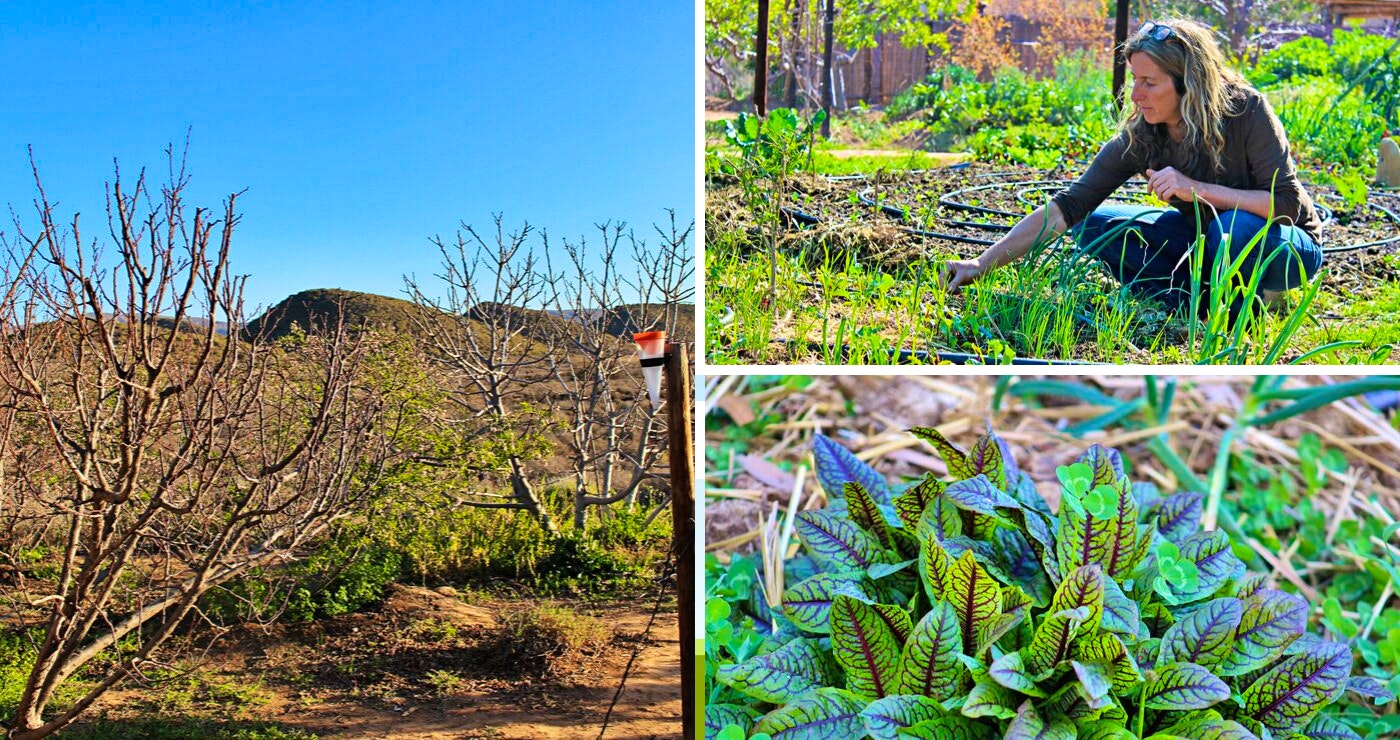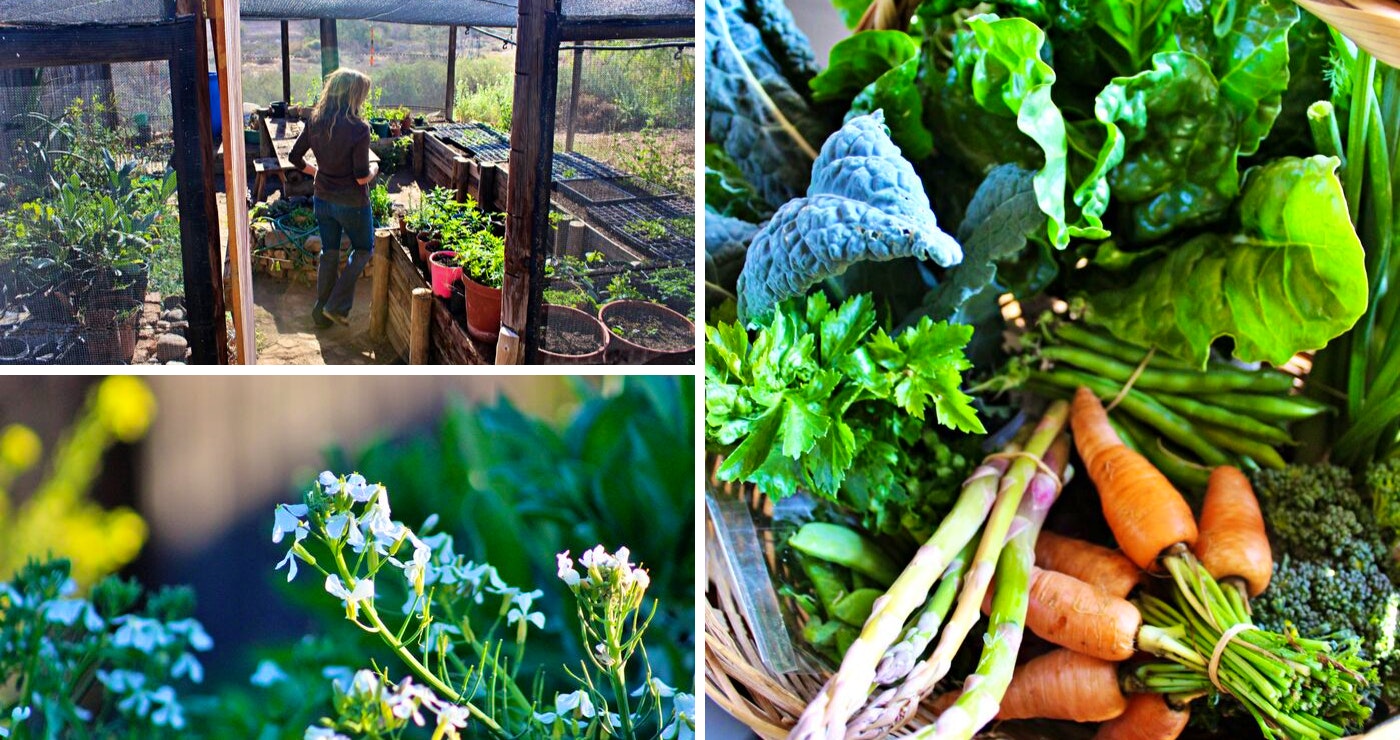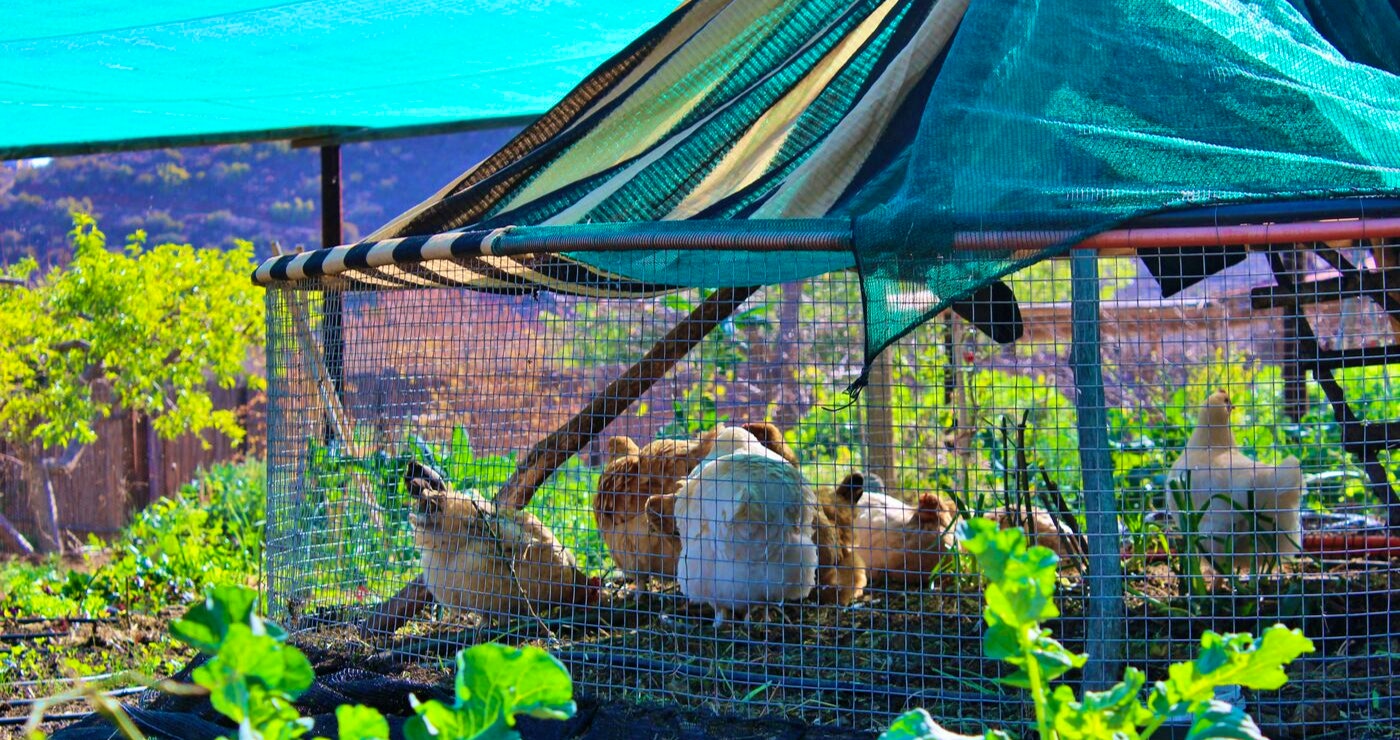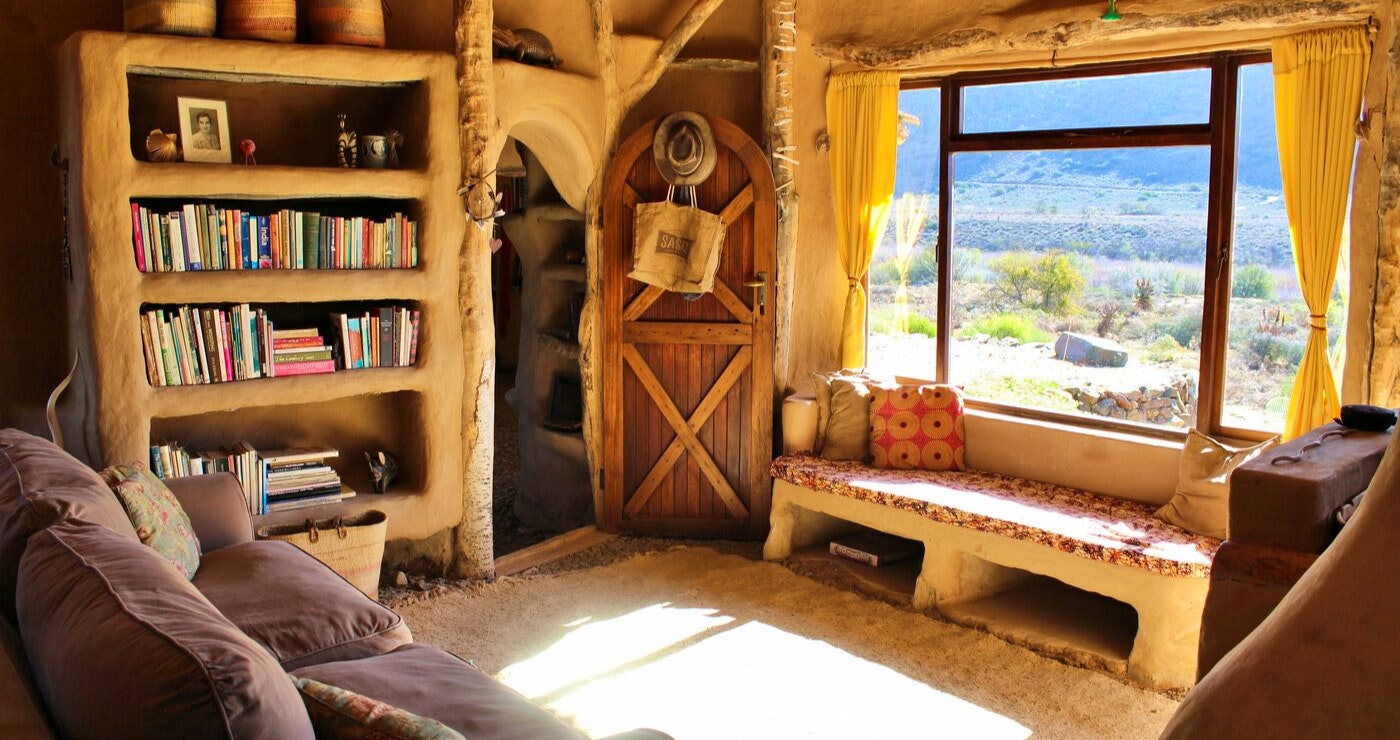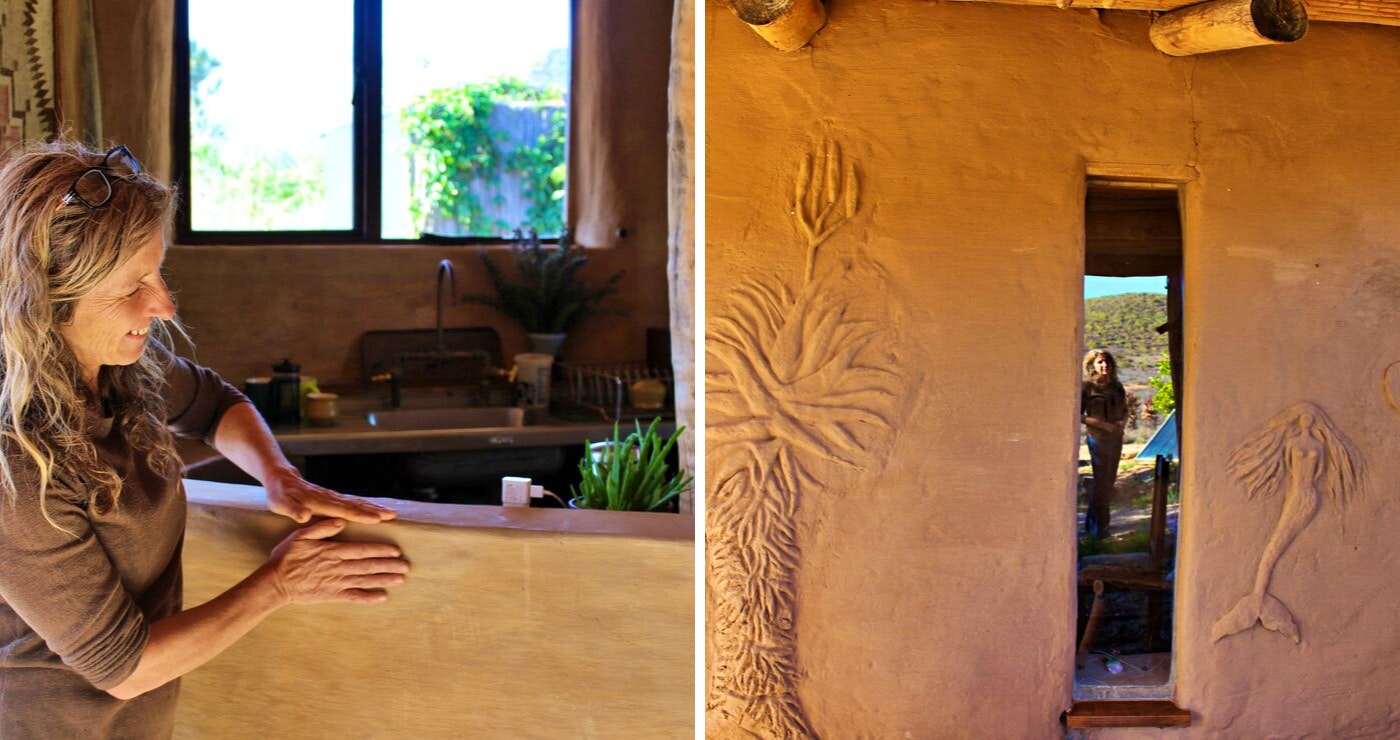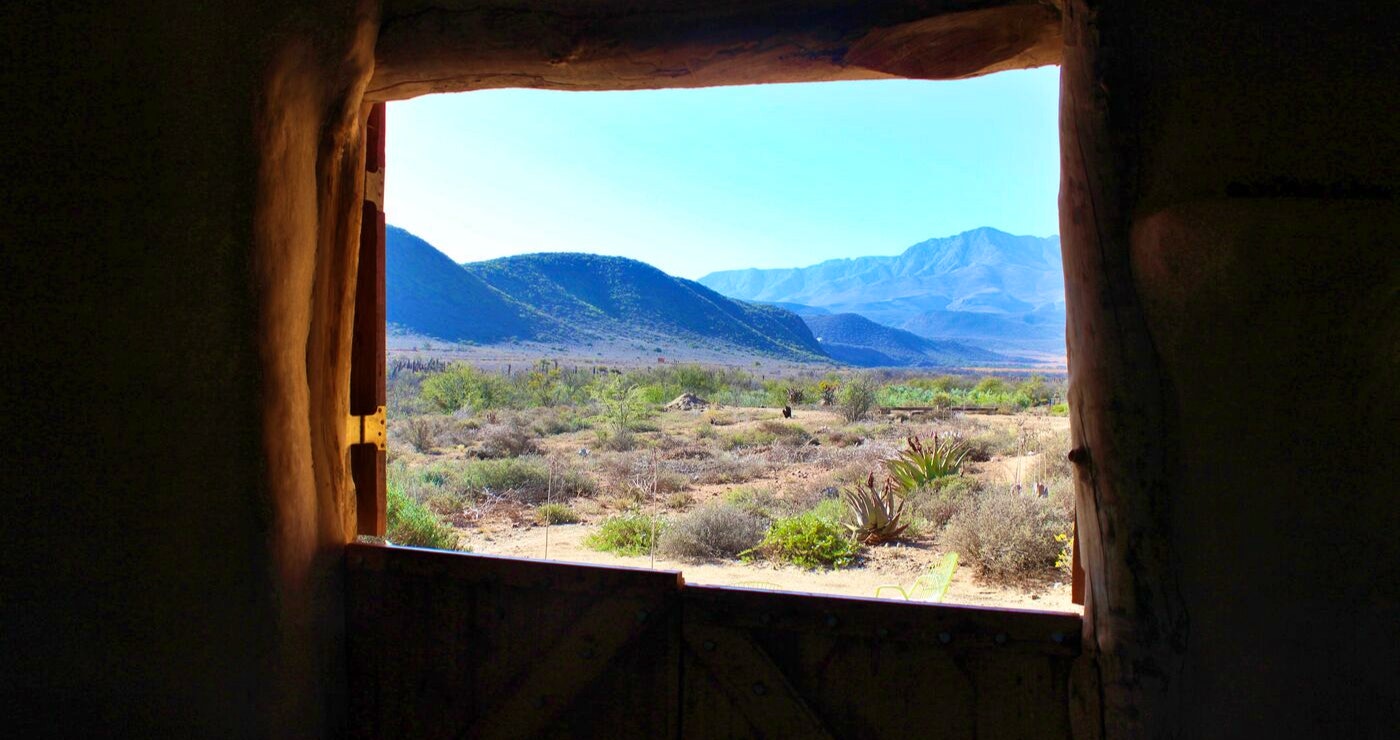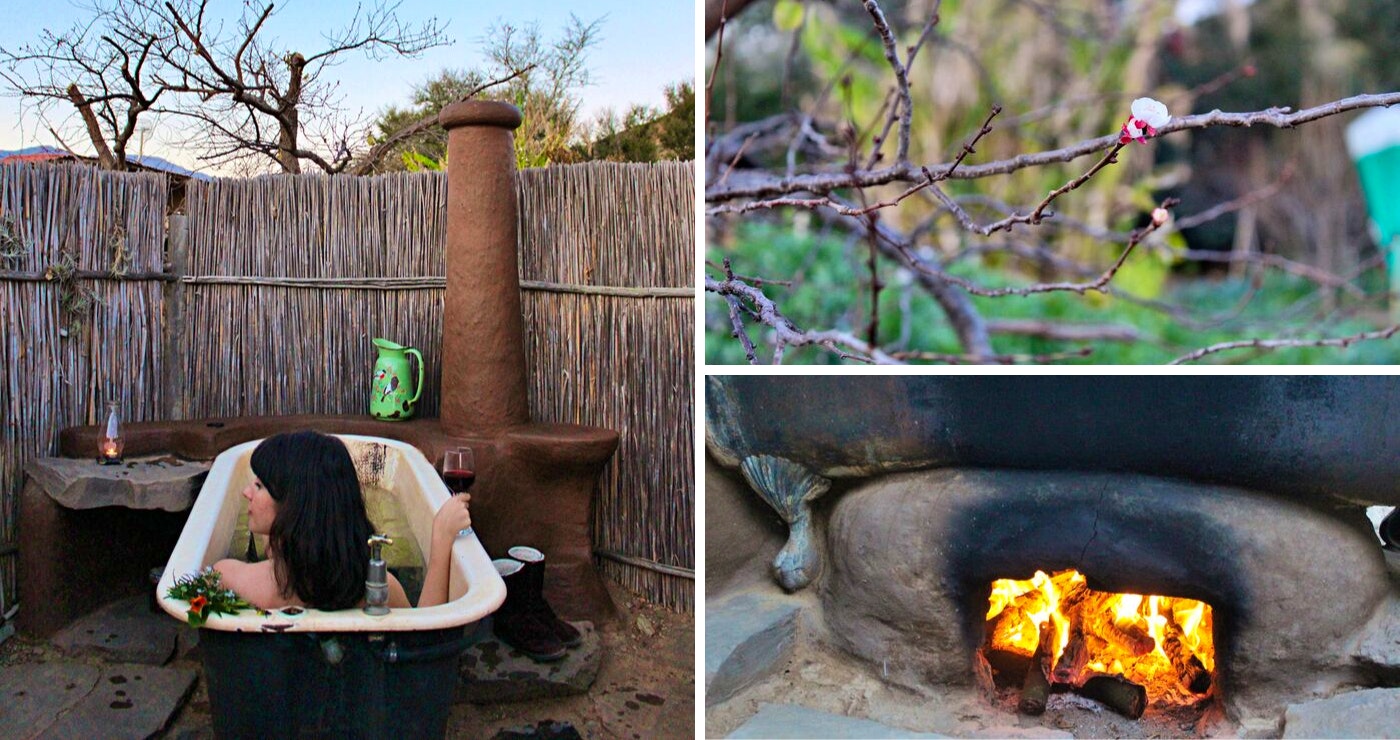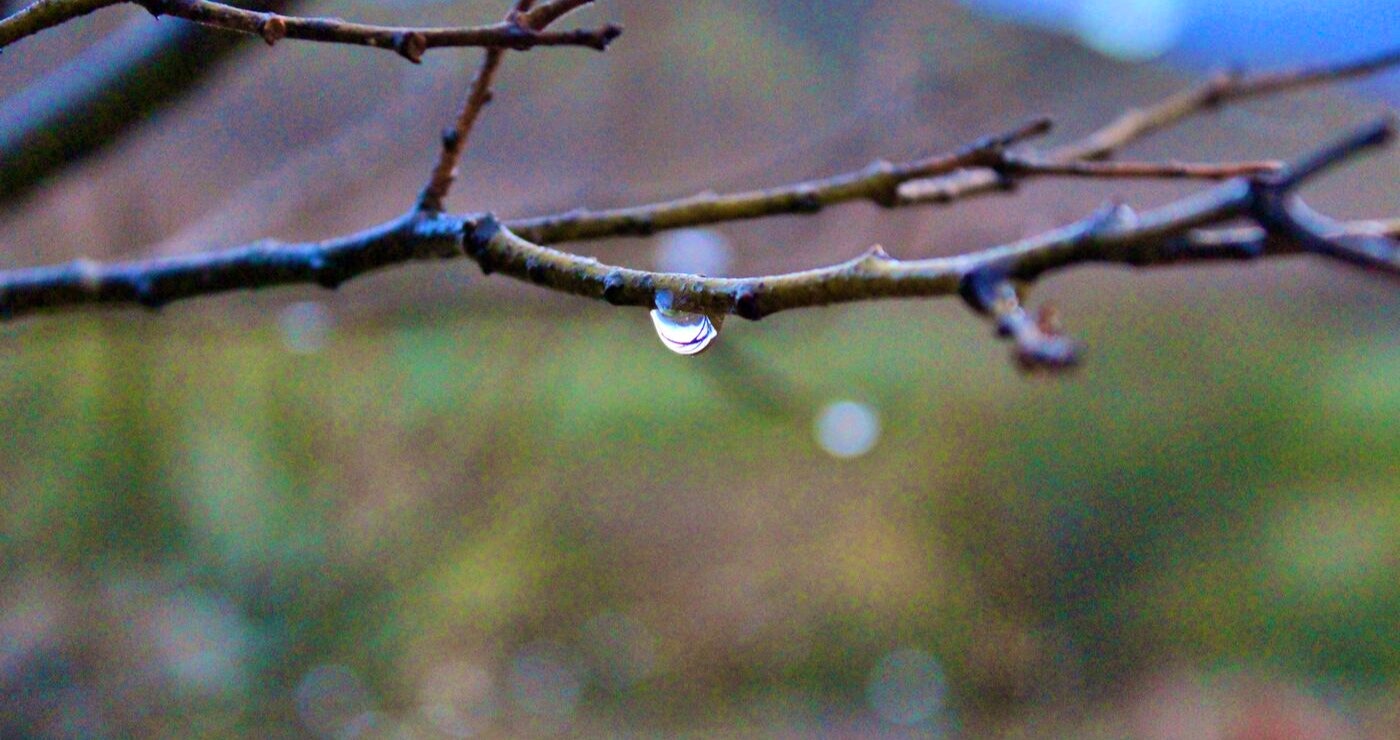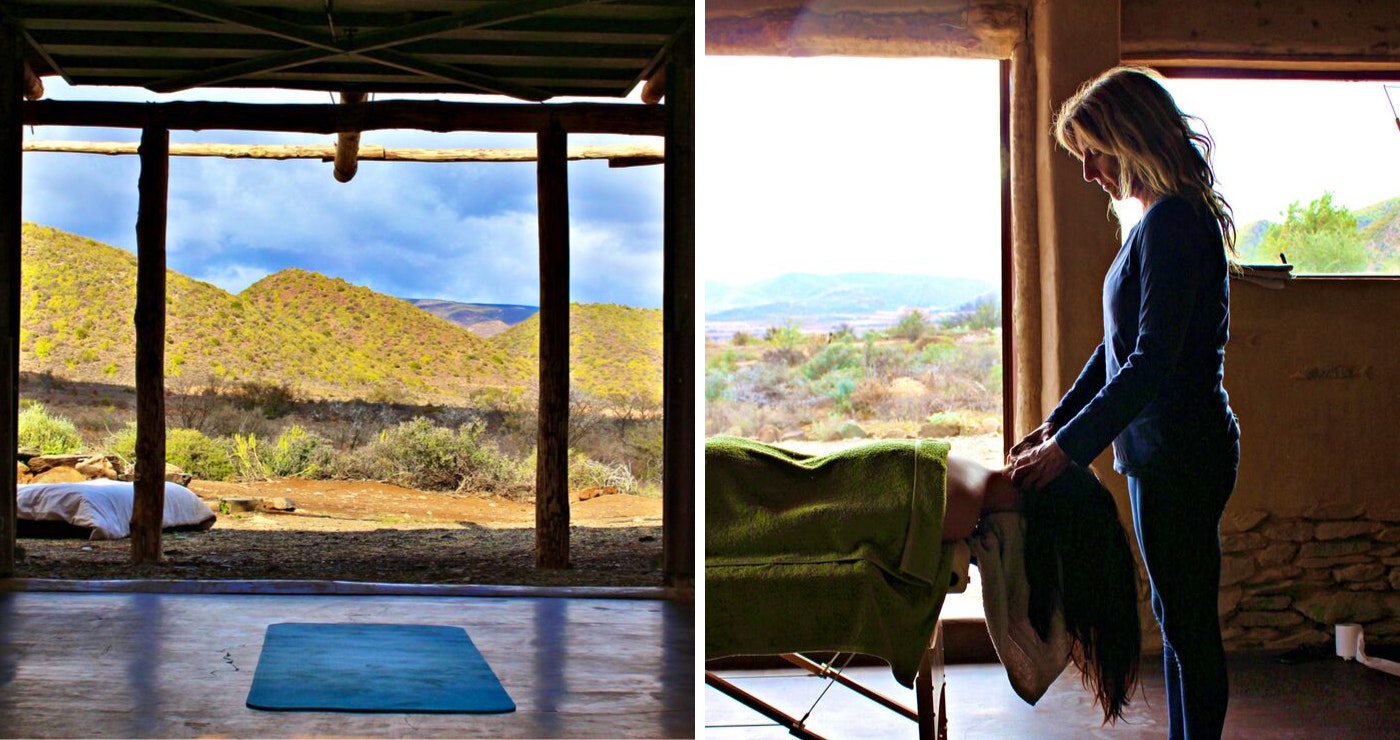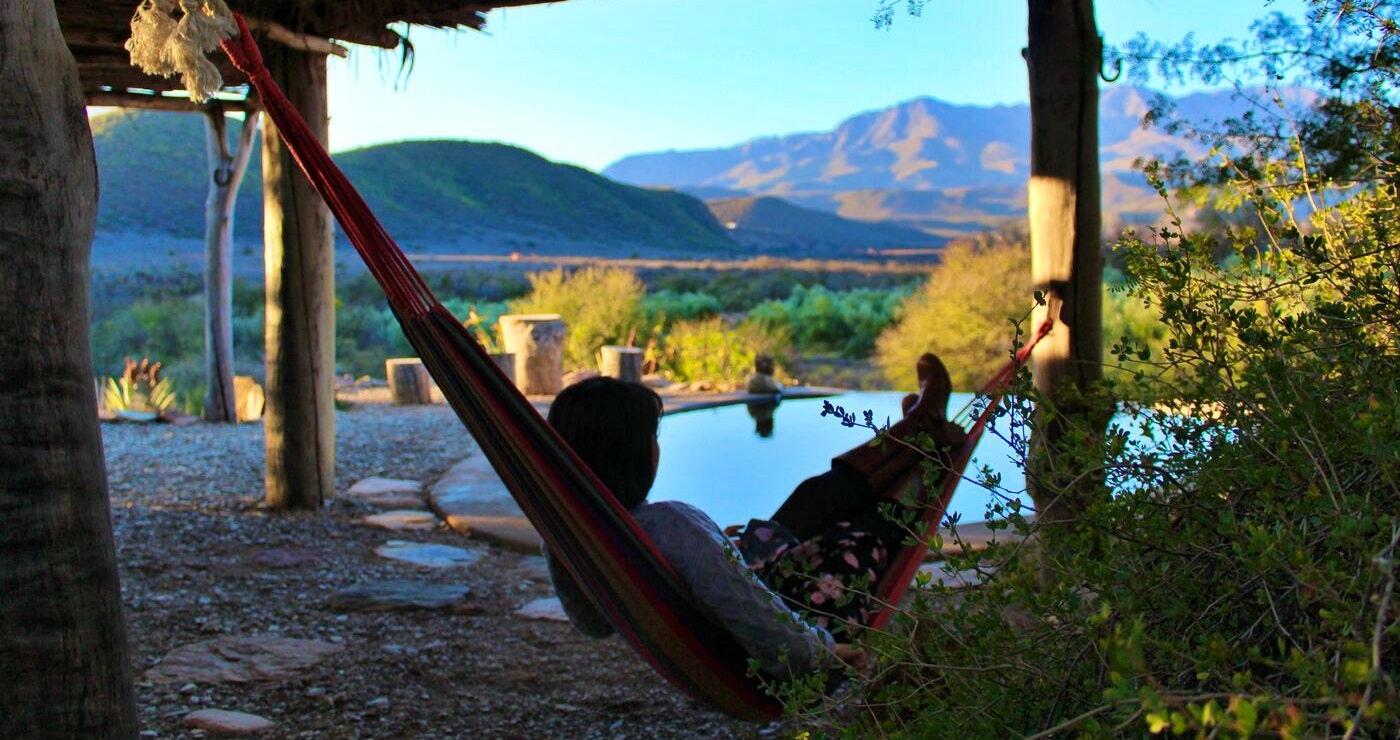As I steer my tiny car along the gravel road to Numbi Valley, there is a sense that the outside world is falling away and by the time we park next to the cottage, the spell of this secluded permaculture farm is complete. At Numbi, like in a child’s play world, flower-ladened baths are taken under open skies, geckos are old friends, chickens are gardeners, homes are fashioned from mud, and food is picked from wild and flourishing gardens. Without a sign of the outside world, it’s just you, your loved ones and a patient valley in shades of sage and lilac stretching out towards the folded mountains.
A cottage with a view
Owner, Kathryn Eybers, greets us on arrival to give us a tour of the four-sleeper cottage. It being the only guest cottage on the farm, guests are ensured exclusive use of the facilities. Everything has been prepared for our convenience. The fireplace in the living area is packed and ready to light and the afternoon sun has made itself comfortable in the main bedroom. Though the cottage is off the grid with a 200L solar geyser, there is enough hot water for a proper shower and, if not, a cast-iron wood-burning stove that acts as a geyser is tindered and set to go.
In the kitchen the basket of vegetables we ordered is waiting to be turned into a scrumptious meal, there is a nifty Wonderbag to ease soup, stew or rice into readiness and we connect to the Wi-Fi and sound system to listen to some music as we get settled. I silently notice that the copper letters tied to the four light switches in the house, spell ‘love’ ─ which is typical of the sort of detail you’ll find throughout the cottage.
As Kathryn chats with us all the way to the veranda, we get a brief history of this sixty-hectare farm: when they inherited it, the cottage, which was the only structure on the property, was a labourer’s house with no floor and half walls. The cottage has also been the dwelling of two rare geckos ever since ─ they’re very pleased with what the Eyberses have done with the place.
One of the first things the couple set out to do was restore the soil, which was over-salinated by years of ostrich farming. To achieve this they planted a hectare of olive trees and, as they waited for these to mature and bear fruit, grew organic vegetables and herbs among the roots. This way, Kathryn and Ross supplied twenty households and restaurants in nearby De Rust with fresh produce while waiting for their first olive harvest. The Eybers family lived in the renovated cottage for five years until the olive trees had grown big and strong ─ to this day these trees form the first tier to one’s view from the veranda.
But the view is just as stunning from the pool which is filled with fresh spring water and filtered through waterblommetjies (now in bloom!) to ensure it stays fresh and chlorine free. ‘Guests come here thinking they’re going to the Cango Caves and then end up just to-ing and fro-ing between the cottage and the pool,’ Kathryn laughs.
Off the pool is a hammock and wood-fired cob pizza oven where, at extra cost, guests can enjoy catered cheesy feasts. On our way back to the cottage, we pass the outside fire pit raked in concentric circles ─ we are indeed spoiled for choice with where to enjoy our dinner! With a smile and the words, ‘If you’d like, come and find me. I’m either in the house or the garden,’ Kathryn departs through the gate at the back of the property, leaving us to settle in.
Bathed in a glorious garden
After we’ve enjoyed some down time, it’s just around the cottage and through the gate to Kathryn’s impressive permaculture garden. It can be quite overwhelming reading up about this way of life; it’s a whole other thing seeing this set design principles in action. And, when Kathryn explains how she and Ross have applied it to their lives and their garden, it seems like child’s play. One can apply permaculture principles to many aspects of life, but on our tour we focus on its application to a garden ─ because what is life but a garden, right?
The basic idea is that nature’s patterns and resilient features be applied to everyday life to offer smart and sustainable solutions. First the couple had to observe Numbi’s ecosystem, what animals and insects interact with it and when, what the seasons are like, and where the light and water naturally comes from. Once they were satisfied that they’d observed enough of Numbi’s natural goings-on that they could work with it without disturbing it, they set to making twenty-eight round garden beds with spiralised irrigation which were planted with loads of different herbs and vegetables to diversify each bed.
As in nature, where plants don’t grow in rows or keep to their own bed, this garden’s beds are planted with a variety of seeds to deliver everything from onions and broad beans to Kakamas yellow peaches and chamomile. This means that if a pest or plague befalls a certain plant, as in nature, another, very different plant next to it might not be susceptible to the same thing and so, by diversifying their crop, the Eyberses are always assured a good harvest. When the plants go to seed, Kathryn collects seeds from those plants she has observed as the strongest and use them for replanting. This has ensured that her crops get stronger and more resilient every year ─ it also explains why the veggie basket we ordered looks so divine!
My favourite thing about Numbi’s garden is the nifty brood of chickens clucking away in what looks like a circus tent. This net tent fits perfectly over a vegetable bed. With the trapeze artist chickens safely inside, any unwanted insects are weeded out and the bed is fertilised at the same time, so that by the time the circus company moves to another bed, the previous one is perfectly prepared for planting. This smart system frees the couple up to do other things … like build their entire home themselves.
To build a house from mud and sticks
Before long we find ourselves in Kathryn and Ross’s handmade home. Built completely from cob, found objects and secondhand finds, it is a testament to the life of sustainability and zero-waste they strive for.
The entire structure, from the shower and the furniture to the kitchen counters and the fireplace, was built from the centre of the living room floor using only a tarpaulin, rechargeable drill, chainsaw and a mixture of mud and straw ─ and it’s a beautiful sight! With views of the valley, a flat roof where you can sleep under the stars and large shutters in the bedroom that open up to let the veld in, one is soon convinced of the miracle of cob-building, as are the volunteers from WWOOF (Willing Workers On Organic Farms) that the Eyberses take in from time to time.
Kathryn smiles as she demonstrates the process of sculpting her home with her own two hands and proudly shows us the side of the house where friends’ children have made their mark, sculpting a mermaid, aloe and sunflower into the wall. More than shelter, for me this home is a massive creative project that my palms are itching to try. For non-creatives: don’t fear! You can be as creative or practical as you like, says Kathryn, and build a Gaudi-esque structure or make the walls completely straight.
As they walked in the veld, she and Ross would spot a great piece of wood and cob that into the wall as a floating shelf, or use an old glass table top as a window in the bathroom. Creative problem-solving is the name of this game: the wood for the ceiling beams were taken off a neighbour’s hands when he had to get rid of the poplar trees that were sucking the river dry. By using found and natural objects, the only building waste the Eyberses were left with after eight months was one Checkers bag of plumbing tape and the empty linseed oil container used to make the house waterproof.
As it is getting dark now, we finally walk around the back of the house to the garden’s end where, hidden behind a spiral wall of dried Spanish reeds, is a thing of legends ─ a cob fire bath. Kathryn prepares the water by tossing in a handful of epsom salt and a tiny bouquet of herbs and flowers. As soon as I can fetch my towel and robe, I find myself back here reclining like a queen in the luke-warm water with the garden keeping me company as the sun makes a rosy bow over the mountains.
Waking to rain and rejuvenation
We get an early start the next morning. Though my bed was warm and cosy, I awoke twice during the night. Passing through De Rust the previous afternoon, we’d heard conversations by concerned townsfolk about the lack of rain in the Klein Karoo. What wakes me is the relief of raindrops on the window sill and by morning we learn that the much doubted 1.7 mm rain that had been predicted had swelled to 3 mm!
After breakfast we tramp through the soaked veld to meet Kathryn. She is in her studio ready for a light yoga session. We made sure that she knew our (lack of) yoga capabilities before greeting her the previous evening and she has graciously chosen a light routine we can also do. Apart from private and regular yoga classes, Kathryn is also a qualified trigger-point masseuse and both these treats can be arranged with her at extra cost during your stay.
As the last raindrops syphon away into the earth, we pack the car and hit the same gravel road. The outside world dawns on us as we near town, but it’s no matter. Having experienced Numbi’s magic firsthand, we won’t forget that with a little effort and a good heart, life could be a dream … sweetheart.
A very special thanks to Kathryn and Ross Eybers from Numbi Valley who graciously hosted us for the night.
All photos taken by Adriëtte le Roux.

